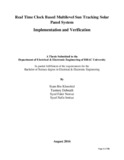| dc.contributor.advisor | Rahman, Dr. Md. Mosaddequr | |
| dc.contributor.author | Khurshid, Siam Bin | |
| dc.contributor.author | Debnath, Tanmoy | |
| dc.contributor.author | Nawaz, Syed Fakir | |
| dc.contributor.author | Imtiaz, Syed Nafiz | |
| dc.date.accessioned | 2016-09-19T10:26:47Z | |
| dc.date.available | 2016-09-19T10:26:47Z | |
| dc.date.copyright | 2016 | |
| dc.date.issued | 2016-08 | |
| dc.identifier.other | ID 12121110 | |
| dc.identifier.other | ID 12121136 | |
| dc.identifier.other | ID 12121157 | |
| dc.identifier.other | ID 12321056 | |
| dc.identifier.uri | http://hdl.handle.net/10361/6416 | |
| dc.description | This thesis report is submitted in partial fulfillment of the requirements for the degree of Bachelor of Science in Electrical and Electronic Engineering, 2016. | en_US |
| dc.description | Cataloged from PDF version of thesis report. | |
| dc.description | Includes bibliographical references (page 85). | |
| dc.description.abstract | Solar energy has originated to be a feasible source of renewable energy over the past two or three decades as this has been used to power up our industrial and domestic applications and gain desired national production. Bangladesh, like some other third world countries, has higher demand of energy than production met by the power sector, even after considering only 70% of the population who are hitherto under electricity coverage of national grid. An inevitable consequence of this shortage is load-shedding, and people of urban areas are major sufferer of it because of their dependency on electricity for quotidian activities. Although solar energy has the promise and potential to solve the energy crisis of Bangladesh, the limited space for setting enough solar photovoltaic (PV) panels to meet the demand of city dwellers emerges as a constraint in implementing solar energy system in densely populated urban areas. In the proposed system, a modified structure equipped with a sliding mechanism holds three solar panels. The panels are stacked one above another in a rack to minimize the floor area, and track the sun using a sun tracking system to maximize power generation. This work focuses on the implementation of the proposed system and verification of its claims. The implementation has been carried out by constructing a physical structure equipped with servo motors controlled by a microcontroller to rotate the panels on a horizontal axis. The Microcontroller determines the appropriate position of the panels for maximum power absorption for a particular time using a real time clock and a set of equations. The data of current and voltages of each panel are collected using a data logger device developed for this purpose. The collected data are then analyzed, which show a high level of conformity to the theoretically calculated values. The Microcontroller determines the appropriate position of the panels for maximum power absorption for a particular time using a real time clock and a set of equations. The panels are supported by a metal rod fixed at a tilted angle equal to the latitude among north-south direction facing south (23°). The panels rotate throughout the day from sunrise to sunset through servo motors controlled by microcontroller. It allows rotation of the three panels on a fixed horizontal axis to track the sun at hourly intervals and maximize power generation. The entire position of the three panels is changed by the actuator after midday when the sun moves from east to west. The projected system will give a worthwhile solution to electricity problems in urban areas where space is inadequate. | en_US |
| dc.description.statementofresponsibility | Siam Bin Khurshid | |
| dc.description.statementofresponsibility | Tanmoy Debnath | |
| dc.description.statementofresponsibility | Syed Fakir Nawaz | |
| dc.description.statementofresponsibility | Syed Nafiz Imtiaz | |
| dc.format.extent | 96 pages | |
| dc.language.iso | en | en_US |
| dc.publisher | BRAC University | en_US |
| dc.rights | BRAC University thesis are protected by copyright. They may be viewed from this source for any purpose, but reproduction or distribution in any format is prohibited without written permission. | |
| dc.subject | Multilevel solar system | en_US |
| dc.subject | Solar panel | en_US |
| dc.subject | Servo motor | en_US |
| dc.subject | Servo controller | en_US |
| dc.title | Real time clocked based multilevel solar system: implementation and verification | en_US |
| dc.type | Thesis | en_US |
| dc.contributor.department | Department of Electrical and Electronic Engineering, BRAC University | |
| dc.description.degree | B. Electrical and Electronic Engineering | |

